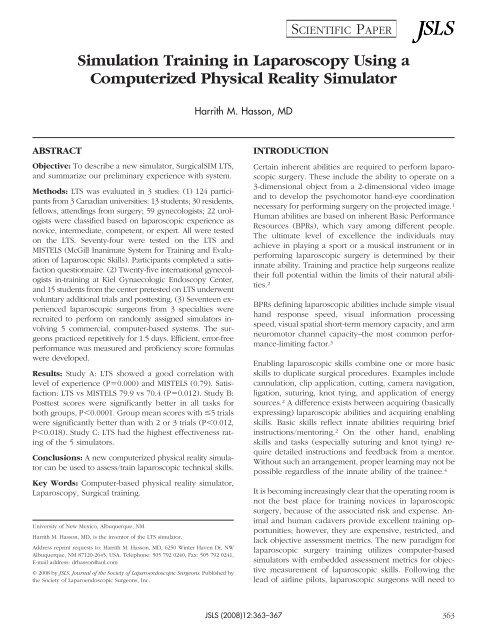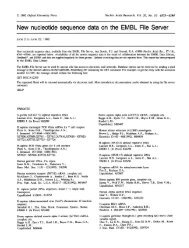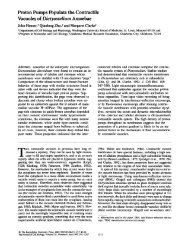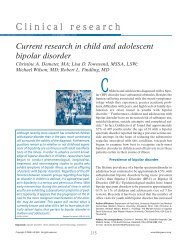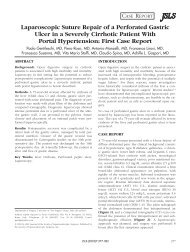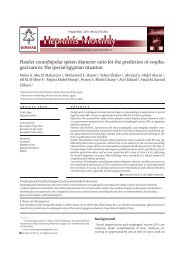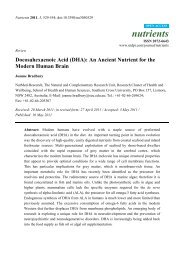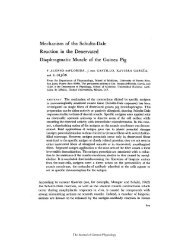Simulation Training in Laparoscopy Using a ... - BioMedSearch
Simulation Training in Laparoscopy Using a ... - BioMedSearch
Simulation Training in Laparoscopy Using a ... - BioMedSearch
Create successful ePaper yourself
Turn your PDF publications into a flip-book with our unique Google optimized e-Paper software.
ABSTRACT<br />
<strong>Simulation</strong> <strong>Tra<strong>in</strong><strong>in</strong>g</strong> <strong>in</strong> <strong>Laparoscopy</strong> Us<strong>in</strong>g a<br />
Computerized Physical Reality Simulator<br />
Objective: To describe a new simulator, SurgicalSIM LTS,<br />
and summarize our prelim<strong>in</strong>ary experience with system.<br />
Methods: LTS was evaluated <strong>in</strong> 3 studies: (1) 124 participants<br />
from 3 Canadian universities: 13 students; 30 residents,<br />
fellows, attend<strong>in</strong>gs from surgery; 59 gynecologists; 22 urologists<br />
were classified based on laparoscopic experience as<br />
novice, <strong>in</strong>termediate, competent, or expert. All were tested<br />
on the LTS. Seventy-four were tested on the LTS and<br />
MISTELS (McGill Inanimate System for <strong>Tra<strong>in</strong><strong>in</strong>g</strong> and Evaluation<br />
of Laparoscopic Skills). Participants completed a satisfaction<br />
questionnaire. (2) Twenty-five <strong>in</strong>ternational gynecologists<br />
<strong>in</strong>-tra<strong>in</strong><strong>in</strong>g at Kiel Gynaecologic Endoscopy Center,<br />
and 15 students from the center pretested on LTS underwent<br />
voluntary additional trials and posttest<strong>in</strong>g. (3) Seventeen experienced<br />
laparoscopic surgeons from 3 specialties were<br />
recruited to perform on randomly assigned simulators <strong>in</strong>volv<strong>in</strong>g<br />
5 commercial, computer-based systems. The surgeons<br />
practiced repetitively for 1.5 days. Efficient, error-free<br />
performance was measured and proficiency score formulas<br />
were developed.<br />
Results: Study A: LTS showed a good correlation with<br />
level of experience (P�0.000) and MISTELS (0.79). Satisfaction:<br />
LTS vs MISTELS 79.9 vs 70.4 (P�0.012). Study B:<br />
Posttest scores were significantly better <strong>in</strong> all tasks for<br />
both groups, P�0.0001. Group mean scores with �5 trials<br />
were significantly better than with 2 or 3 trials (P�0.012,<br />
P�0.018). Study C: LTS had the highest effectiveness rat<strong>in</strong>g<br />
of the 5 simulators.<br />
Conclusions: A new computerized physical reality simulator<br />
can be used to assess/tra<strong>in</strong> laparoscopic technical skills.<br />
Key Words: Computer-based physical reality simulator,<br />
<strong>Laparoscopy</strong>, Surgical tra<strong>in</strong><strong>in</strong>g.<br />
University of New Mexico, Albuquerque, NM.<br />
Harrith M. Hasson, MD, is the <strong>in</strong>ventor of the LTS simulator.<br />
Address repr<strong>in</strong>t requests to: Harrith M. Hasson, MD, 6250 W<strong>in</strong>ter Haven Dr, NW<br />
Albuquerque, NM 87120-2645, USA. Telephone: 505 792 0240, Fax: 505 792 0241,<br />
E-mail address: drhasson@aol.com<br />
© 2008 by JSLS, Journal of the Society of Laparoendoscopic Surgeons. Published by<br />
the Society of Laparoendoscopic Surgeons, Inc.<br />
Harrith M. Hasson, MD<br />
SCIENTIFIC PAPER<br />
INTRODUCTION<br />
Certa<strong>in</strong> <strong>in</strong>herent abilities are required to perform laparoscopic<br />
surgery. These <strong>in</strong>clude the ability to operate on a<br />
3-dimensional object from a 2-dimensional video image<br />
and to develop the psychomotor hand-eye coord<strong>in</strong>ation<br />
necessary for perform<strong>in</strong>g surgery on the projected image. 1<br />
Human abilities are based on <strong>in</strong>herent Basic Performance<br />
Resources (BPRs), which vary among different people.<br />
The ultimate level of excellence the <strong>in</strong>dividuals may<br />
achieve <strong>in</strong> play<strong>in</strong>g a sport or a musical <strong>in</strong>strument or <strong>in</strong><br />
perform<strong>in</strong>g laparoscopic surgery is determ<strong>in</strong>ed by their<br />
<strong>in</strong>nate ability. <strong>Tra<strong>in</strong><strong>in</strong>g</strong> and practice help surgeons realize<br />
their full potential with<strong>in</strong> the limits of their natural abilities.<br />
2<br />
BPRs def<strong>in</strong><strong>in</strong>g laparoscopic abilities <strong>in</strong>clude simple visual<br />
hand response speed, visual <strong>in</strong>formation process<strong>in</strong>g<br />
speed, visual spatial short-term memory capacity, and arm<br />
neuromotor channel capacity–the most common performance-limit<strong>in</strong>g<br />
factor. 3<br />
Enabl<strong>in</strong>g laparoscopic skills comb<strong>in</strong>e one or more basic<br />
skills to duplicate surgical procedures. Examples <strong>in</strong>clude<br />
cannulation, clip application, cutt<strong>in</strong>g, camera navigation,<br />
ligation, sutur<strong>in</strong>g, knot ty<strong>in</strong>g, and application of energy<br />
sources. 2 A difference exists between acquir<strong>in</strong>g (basically<br />
express<strong>in</strong>g) laparoscopic abilities and acquir<strong>in</strong>g enabl<strong>in</strong>g<br />
skills. Basic skills reflect <strong>in</strong>nate abilities requir<strong>in</strong>g brief<br />
<strong>in</strong>structions/mentor<strong>in</strong>g. 2 On the other hand, enabl<strong>in</strong>g<br />
skills and tasks (especially sutur<strong>in</strong>g and knot ty<strong>in</strong>g) require<br />
detailed <strong>in</strong>structions and feedback from a mentor.<br />
Without such an arrangement, proper learn<strong>in</strong>g may not be<br />
possible regardless of the <strong>in</strong>nate ability of the tra<strong>in</strong>ee. 4<br />
It is becom<strong>in</strong>g <strong>in</strong>creas<strong>in</strong>gly clear that the operat<strong>in</strong>g room is<br />
not the best place for tra<strong>in</strong><strong>in</strong>g novices <strong>in</strong> laparoscopic<br />
surgery, because of the associated risk and expense. Animal<br />
and human cadavers provide excellent tra<strong>in</strong><strong>in</strong>g opportunities;<br />
however, they are expensive, restricted, and<br />
lack objective assessment metrics. The new paradigm for<br />
laparoscopic surgery tra<strong>in</strong><strong>in</strong>g utilizes computer-based<br />
simulators with embedded assessment metrics for objective<br />
measurement of laparoscopic skills. Follow<strong>in</strong>g the<br />
lead of airl<strong>in</strong>e pilots, laparoscopic surgeons will need to<br />
JSLS (2008)12:363–367 363
<strong>Simulation</strong> <strong>Tra<strong>in</strong><strong>in</strong>g</strong> <strong>in</strong> <strong>Laparoscopy</strong> Us<strong>in</strong>g a Computerized Physical Reality Simulator, Hasson HM<br />
Figure 1. Set Up 1 : Storage 2 ; Cover opened 3 ; Monitor unfolded 4 ; Cover closed 5 ; Insert <strong>in</strong>struments; simulator ready for practice.<br />
rely on computer-based simulation systems for ongo<strong>in</strong>g<br />
skill tra<strong>in</strong><strong>in</strong>g and assessment outside the operat<strong>in</strong>g room.<br />
The advantage of the new simulator system is that it<br />
comb<strong>in</strong>es realistic haptics-based skill exercises found <strong>in</strong> a<br />
box tra<strong>in</strong>er with the objective assessment capability of<br />
virtual-reality systems.<br />
MATERIALS AND METHODS<br />
The METI SurgicalSIM LTS (www.METI.com) is a self-conta<strong>in</strong>ed<br />
patent-pend<strong>in</strong>g computer-enhanced <strong>in</strong>teractive laparoscopic<br />
physical reality simulator. It was previously named<br />
LTS3e and represents an updated version of the LTS2000-<br />
ISM60 where the same components were not <strong>in</strong>tegrated. 5<br />
The system is suitable for test<strong>in</strong>g and tra<strong>in</strong><strong>in</strong>g of basic and<br />
enabl<strong>in</strong>g laparoscopic skills. Sensors embedded with<strong>in</strong> the<br />
364<br />
JSLS (2008)12:363–367<br />
Figure 2. Cover opened, monitor unfolded, sensor carousel<br />
exposed.
Figure 3. Simulator ready for practice.<br />
physical modules assess the performance of validated exercises<br />
on the basis of metrics validated at McGill University.<br />
The new simulator consists of an enclosure that can be<br />
folded so as to be stored and transported <strong>in</strong> a compact<br />
configuration. A series of simple steps transforms the<br />
system <strong>in</strong>to an active configuration (Figure 1). The enclosure<br />
houses a revolv<strong>in</strong>g sensor carousel (Figure 2). A<br />
fold<strong>in</strong>g cover covers the carousel and conta<strong>in</strong>s ports<br />
through which laparoscopic <strong>in</strong>struments are <strong>in</strong>serted (Figure<br />
3). The <strong>in</strong>struments shown <strong>in</strong> Figure 4 are used to<br />
perform procedures on physical models mounted on the<br />
carousel. The physical models have embedded sensors<br />
that sense and monitor the performance of each exercise.<br />
A computer is housed at the distal end of the enclosure<br />
with an electronic display mounted on the fold<strong>in</strong>g arm. A<br />
digital camera captures and records video. Live video of<br />
Figure 4. Instruments used.<br />
the performance is viewed on an <strong>in</strong>tegrated computer<br />
monitor. Rotat<strong>in</strong>g the sensor carousel provides access to<br />
10 exercises arrayed on 6 stations (Figure 5). Some of the<br />
exercises are repeated with the nondom<strong>in</strong>ant hand. The<br />
validated exercises assess basic laparoscopic coord<strong>in</strong>ation<br />
skills, cannulation, cutt<strong>in</strong>g and sutur<strong>in</strong>g skills, <strong>in</strong>clud<strong>in</strong>g<br />
one that verifies knot <strong>in</strong>tegrity with a disruptive force of 1<br />
kilogram. The adm<strong>in</strong>istrative software supports enroll<strong>in</strong>g<br />
users <strong>in</strong> a database, select<strong>in</strong>g and perform<strong>in</strong>g exercises,<br />
view<strong>in</strong>g and pr<strong>in</strong>t<strong>in</strong>g past and present test reports, watch<strong>in</strong>g<br />
tutorials and shutt<strong>in</strong>g down. The user survey and log<strong>in</strong><br />
functions make it possible to validate <strong>in</strong>dividual or group<br />
improvement <strong>in</strong> performance over time and to establish<br />
benchmark criteria for skill proficiency.<br />
Three studies were conducted to evaluate the simulator. The<br />
first study conta<strong>in</strong>ed 124 participants from 3 Canadian universities<br />
<strong>in</strong>clud<strong>in</strong>g 13 medical students; 30 residents, fellows,<br />
attend<strong>in</strong>gs from surgery; 59 from gynecology; and 22 from<br />
urology who were classified <strong>in</strong>to groups based on laparoscopic<br />
experience as novice, <strong>in</strong>termediate, competent, expert.<br />
All were tested on the LTS-ISM60, and 74 were tested<br />
on both the LTS and the MISTELS (McGill Inanimate System<br />
for <strong>Tra<strong>in</strong><strong>in</strong>g</strong> and Evaluation of Laparoscopic Skills). Participants<br />
completed a satisfaction questionnaire. 6 The second<br />
study <strong>in</strong>volved 25 <strong>in</strong>ternational gynecologists <strong>in</strong>-tra<strong>in</strong><strong>in</strong>g at<br />
Kiel School of Gynaecologic Endoscopy and 15 medical students<br />
from the same center. All were pretested on the LTS3e<br />
and had voluntary additional trials followed by posttest<strong>in</strong>g. 7<br />
In both studies, the performance was assessed with embedded<br />
McGill metrics: a preset maximum allowable time is<br />
established for each exercise/task. The speed score is calcu-<br />
JSLS (2008)12:363–367 365
<strong>Simulation</strong> <strong>Tra<strong>in</strong><strong>in</strong>g</strong> <strong>in</strong> <strong>Laparoscopy</strong> Us<strong>in</strong>g a Computerized Physical Reality Simulator, Hasson HM<br />
Figure 5. Sensor carousel.<br />
Table 1.<br />
Summarized Results of Canadian Study 6<br />
Number of Participants�124<br />
LTS showed good correlation with level of experience<br />
(P�0.000) and MISTELS (r�0.79)<br />
Level of participant satisfaction greater for LTS (79.9) vs<br />
MISTELS (70.4); P�0.012<br />
Table 2.<br />
Summarized Results of German Study 7<br />
Number of Participants�25 attend<strong>in</strong>g gynecologists; 15<br />
medical students<br />
Posttest scores significantly better <strong>in</strong> all tasks for both groups<br />
(P�0.0001)<br />
Group mean scores with 5 or more trials significantly better<br />
than with 2 or 3 trials (P�0.012, P�0.018)<br />
lated by subtract<strong>in</strong>g completion time from maximum time.<br />
Penalty po<strong>in</strong>ts are deducted from the speed score for committ<strong>in</strong>g<br />
errors or for lack of precision. The net score is the<br />
speed score m<strong>in</strong>us penalty po<strong>in</strong>ts. 8 In the third study, 17<br />
experienced laparoscopic surgeons <strong>in</strong>clud<strong>in</strong>g 7 <strong>in</strong> general<br />
surgery, 6 <strong>in</strong> gynecology, 3 <strong>in</strong> urology, and 1 unknown were<br />
recruited. The surgeons performed on randomly assigned<br />
simulator stations <strong>in</strong>volv<strong>in</strong>g 5 commercially available, computer-based<br />
simulators: Lap Mentor, Symbionix, Cleveland,<br />
OH; Lap Sim, Surgical Science AB, Göteborg, Sweden; LTS,<br />
RealSim Systems, Albuquerque, NM; Pro MIS, Haptica, Boston,<br />
MA; and SurgicalSIM, METI, Sarasota, FL. The surgeons<br />
366<br />
practiced repetitively for 1 and 1/2 days. Surgeon’s proficiency<br />
def<strong>in</strong>ed as efficient error-free performance was measured,<br />
and proficiency score formulas were developed for<br />
each simulator. 9<br />
RESULTS<br />
Summarized results of the first 2 studies are shown <strong>in</strong><br />
Tables 1 and 2. In the third study, the LTS had the highest<br />
effectiveness rat<strong>in</strong>g of the 5 simulators. 9<br />
CONCLUSION<br />
Prelim<strong>in</strong>ary data <strong>in</strong>dicate that a computerized physical<br />
reality simulator can be used successfully to assess/tra<strong>in</strong><br />
laparoscopic technical skills with good user satisfaction.<br />
References:<br />
JSLS (2008)12:363–367<br />
1. Satava RM, Cusheiri A, Hamdorf J. Metrics for objective<br />
assessment. Surg Endosc. 2003;17:220–226.<br />
2. Hasson HM. Core competency <strong>in</strong> laparoendoscopic surgery.<br />
JSLS. 2006;10:16–20.<br />
3. Gettman MT, Kondraske GV, Traxer O, et al. Assessment of<br />
basic human performance resources predicts operative performance<br />
of laparoscopic surgery. J Am Coll Surg. 2003;197:489–<br />
496.<br />
4. Mahmood T, Darzi A. The learn<strong>in</strong>g curve for a colonoscopy<br />
simulator <strong>in</strong> the absence of feedback: no feedback, no learn<strong>in</strong>g.<br />
Surg Endosc. 2004;18:1224–1230.<br />
5. Hasson HM. The LTS 2000-ISM60 simulator for laparoscopic<br />
skill tra<strong>in</strong><strong>in</strong>g. J Am Assoc Gynecol Laparosc. 2004;<br />
11(Supp 1):S59.
6. Sansregret A, Fried G, Hasson H, et al. How to choose the<br />
right physical laparoscopic simulator? LTS2000-ISM60 compared<br />
to MISTELS: validation, correlation and user’s satisfaction. Am J<br />
Surg. In press.<br />
7. Soy<strong>in</strong>ka A, Gopalghare D, Me<strong>in</strong>hold-Heerle<strong>in</strong> I, Hasson H,<br />
Mettler L. Enhanc<strong>in</strong>g laparoscopic performance with the LTS3e:<br />
a computerized hybrid physical reality simulator. Fertil Steril.<br />
2008 May 24 [Epub ahead of pr<strong>in</strong>t]<br />
8. Derossis AM, Fried GM, Abrahamowicz M, Sigman HH,<br />
Barkun JS, Meak<strong>in</strong>s JL. Development of a model for tra<strong>in</strong><strong>in</strong>g<br />
and evaluation of laparoscopic skills. Am J Surg. 1998;175:<br />
482–487.<br />
9. He<strong>in</strong>richs WL, Lukoff B, Youngblood P, Dev P, Shavelson R, SLS<br />
Committee on Surgical <strong>Simulation</strong>: Hasson HM, Satava RM, McDougall<br />
EM, Wetter PA. Criterion-based tra<strong>in</strong><strong>in</strong>g with surgical simulators: proficiency<br />
of experienced surgeons. JSLS. 2007;11:273–302.<br />
JSLS (2008)12:363–367 367


